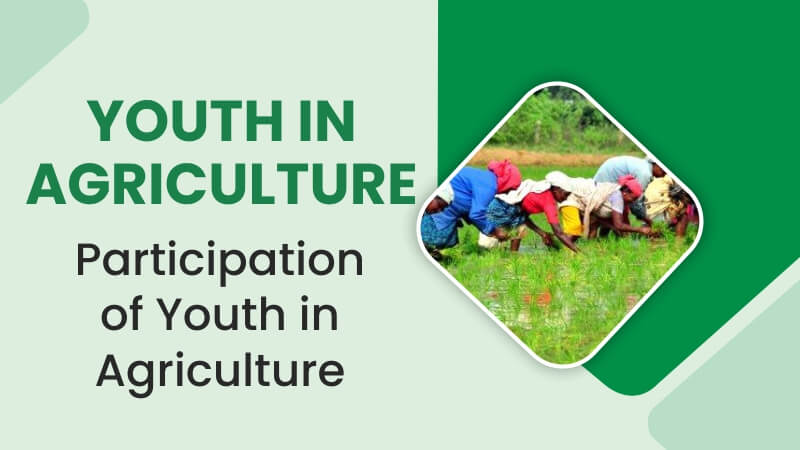Introduction:
Young people are increasingly choosing to pursue non-agricultural jobs rather than following in the footsteps of their parents and grandparents, as the average age of farmers is 60 worldwide. Every country needs youth as a resource, especially for maintaining agricultural output as a crucial sector for nation-building. Unfortunately, although being a crucial time in their transition into adulthood, this group of people is essentially ignored when policies and program considerations are made. The unemployment rate for this group was 12.6% globally in 2010 compared to 4.8% for adults, and this could motivate the majority of adolescents to migrate, particularly to urban centers and beyond since this action gives opportunities for obtaining job prospects. Only if this low level of youth participation is rectified can agriculture, one of the fundamental pillars of any civilization, continue to function as such.
This necessitates securing the interest and participation of young people in agriculture through a deliberate shift in policy, training, and promotion that specifically targets the youth. Youth involvement in agricultural activities has the potential to reduce the issues of the aging farm population and decrease youth unemployment. This group of people serves as the backbone of every society’s economy, a key source of ideas and innovations, the primary market for food consumption, and frequently the influencers and leaders of public opinion, public policy, and social change.
Importance Of Youth in Agriculture:
The growth of the young people affects the growth of the neighborhood and the nation. Rural areas’ socio-economic growth and prosperity are dependent on the nation’s youth. If given the chance, they are priceless human resources who can contribute significantly to efforts to create the country. A nation can make significant and swift progress toward modernization if it can harness the creative and widespread force that is youth. In practically every nation around the globe, youth have been playing a key role because they have the enthusiasm and fitness needed to generate prospects for national growth.
The five stages of agriculture typically include production, processing, storage, marketing, and consumption. Most of these stages allow rural youth to participate actively. Youth from rural areas participate in marketing when the industry is heavily/commercialized. Rural youth are essential in executing a variety of chores associated with dairy and other operations, including the development of activities like feeding animals and gathering fodder for them.
How to Engage Youth in Agriculture?
Although vocational training and extension services have the potential to be effective instruments for developing the capacity of rural youth and teaching agricultural skills, they may not always impart the essential skills, which can lead to poor employment results. Training programs usually lack funds, and service providers have limited capabilities. Many rural kids have low levels of education, which further restricts their options for employment. In addition, in a changing agricultural sector, there is frequently a mismatch between the type of training provided and the needs of the labor market.
For the agriculture industry to grow, higher education is equally important. The development of the agricultural sector of the labor market in an evolving agricultural sector has proven advantageous with the establishment of high-quality colleges that concentrate on agricultural research and forge connections with the farming community.
The problem with Youth participating in Agriculture:
It is alarming to see how our youth are losing interest in and confidence in agriculture and related activities, which is why they aren’t actively participating in farming. Only a few innovations have been accepted despite superb and enormous advancements in science, technology, and agriculture. In any area of development, young people are more open to novel ideas or methods. If given the right training in new agricultural technology, the youth would not only be willing to embrace change but also be able to persuade and inform the farmers’ community about these advances.
The majority of metropolitan kids are educated, involved in several organizations, and have access to facilities and institutions that provide services for young people. Rural adolescents, on the other hand, typically have fewer options for higher education, are responsible for their own families’ needs, lack opportunities to organize themselves to engage in productive labor, and lack supervision for taking part in development activities. Rural kids are interested in a variety of activities, but they are neither driven nor engaged in the development process. This is due to a number of factors, including the absence of national youth programs, a suitable network for youth organizations, a lack of training and direction, and a lack of departmental or sectoral coordination.
All of these elements play a significant role in the often unplanned and coerced movement of young people from rural to urban regions. Therefore, it is necessary to establish various income-generating activities to secure their participation in order to stop this trend of migration and enable them to contribute to the general prosperity of the rural community. Therefore, a nation’s planners and policymakers have always given attention to the development and channeling of youth’s abilities and energies toward positive channels.
Government initiatives to attract youth towards Agriculture:
The Indian government has announced and is announcing a variety of programs to fully utilize the potential of youth and the demographic dividend. These programs are founded on the tenets of social inclusion, gender equality, and rural development that is sustainable. Several of the plans and actions include:
ARYA Program: Attracting and Retaining Youth in Agriculture The Indian Council of Agricultural Research has introduced this program, called ARYA (ICAR). In 25 states across the nation, this program will be carried out through Krishi Vigyan Kendras (KVK-Agriculture Science Centers). Youth in Agriculture: The Role of Government Initiatives Each KVK will train 200 to 300 youth in taking up agriculture’s auxiliary and linked enterprises, such as raising poultry, dairying, and fisheries.
2017goat rearing, mushroom cultivation, and other such activities that keep the rural youth directly or indirectly involved in agriculture. Finally, help would be provided to the trained young business people in creating project reports for bank loan applications.
Skill India: Ability India Entrepreneurship initiatives won’t be successful until and unless the gaps are bridged. In order to meet the demands of the industry and provide its population with an acceptable standard of living, the ecosystem for talent development and entrepreneurship promotion in the nation must be quickly reorganized. However, there are gaps in the capability and quality of the infrastructure for training as well as in its results, as well as a lack of certification and uniform standards, and glaring neglect of the unorganized sector.
Visit the khetigadi mobile application for tractor-related information, such as tractor prices, tractor videos, tractor images, and other agricultural machinery.




